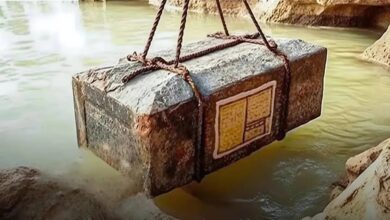Ancient Ammo Unearthed on Lot 7 (Season 12) *Exclusive* | The Curse of Oak Island
Ancient Ammo Unearthed on Lot 7 (Season 12) *Exclusive* | The Curse of Oak Island

A musket ball is
a really important find
because back in the lab
we can try to identify
the country of origin,
and that will help us
narrow down
the list of suspects
as to who could be behind
the Oak Island mystery.
♪ ♪
JACK:
Did you find something out
about the musket ball we found?
I did, yeah.
So this is the musket ball
that you and Gary found
on Lot 7.
-Mm-hmm.
Seems like just
a regular musket ball,
but there are two metrics
we can use to determine caliber.
One is the diameter.
-One’s the weight.
-ALEX: Lot 7.
I don’t remember finding
a lot of musket balls
on that part of the island.
No, we really haven’t, right?
This is probably close
to the only one, right?
-Yeah.
I mean, most of them,
it seems to come
off Lot 24, 25, 26.
Yeah.
When we measure this,
it’s 0.654 inches.
-Okay.
-Right?
And it’s 22.7 grams.
JACK:
So, what?
The size and the weight
say something special?
LAIRD:
The size and the weight.
We have this, uh– a formula
it’s been– that was developed
by an archaeologist
-who specialized
in musket balls.
-Mm.
And when we plug the numbers in,
what it is, it’s .69 caliber,
which would make it
so it fits a Charleville musket,
a French musket.
-BOTH: Oh.
-Right?
When was that
specific French rifle used?
Mid-1700s to later,
but what’s potentially
significant is
that during
the Revolutionary War,
Americans at the time
used Charleville muskets.
That’s not mundane at all.
That’s pretty cool.
LAIRD:
Yeah. Supplied by the French.
-Yeah.
-Mm-hmm.
-Time period-wise…
-LAIRD: Time period-wise.
…were the French
likely here then?
Or was someone– had someone
inherited this old…?
LAIRD:
Well, this is the thing.
The musket ball was made
to fit the, uh…
The specific gun.
The French musket.
How do we know, specifically,
this is a musket ball
from the late 1700s?
I mean, musket balls have been
used since, like, the 1500s.
So, I mean,
could it come
from an earlier date?
Not very much earlier.
I wouldn’t put it
any earlier than 1730s.
This was probably
made on the island.
I can’t say for sure.
-Is it lead?
-It is lead.
So it is, um, about 86% lead,
and then the rest
being majority tin,
and then some copper.
There was a bit of iron
and-and aluminum content,
but I think it’s from the soil.
What makes you say, though,
Laird, that it could have been
-made on the island?
-LAIRD: Well, I think if the,
if the rifle was a Charleville,
no matter where it came from,
it would have traveled
with its shot molds.
-Mm-hmm.
-Right?
And lead would have been
a common thing to have around,
and people could have
easily poured their own.
ALEX:
Is it the kind of thing that
in any way would
have been reused?
-Yeah.
-EMMA: Oh, yeah.
-Yeah.
-Yeah?
-EMMA: So yeah.
You can easily pick one up,
and then melt it
and reuse it again.
So that iron
and-and aluminum content
and even some of that
silica content I’m picking up,
that could actually be
from the-the ball itself.
Right, so like fired,
hits a tree…
-EMMA: Yeah.
-…gets all dinged up,
and you collect it,
you melt it down again
with some of the soil
that it hit.
Yeah, definitely possible.
-LAIRD: Right.
-JACK: In my mind,
it comes from some sort
of a-a French influence
coming to the island,
and maybe they weren’t here
necessarily long and maybe
they weren’t firing shots
but someone dropped
a musket ball.
Yeah.
Well, at the end of the day,
if it’s– if it really is
French in origin,
it’s just another little piece
of evidence in favor,
possibility of the
Duc d’Anville’s expedition here.
Yeah, exactly.
ALEX:
If this musket ball from Lot 7
is indeed French, it adds
to the body of evidence
that supports
our potential theories.
The Duc d’Anville
and a French expedition
of some kind may have left
a treasure deposit
on Oak Island.
It fits into that whole
French or British…
-Yeah.
-…question that we have here.
Exactly. Yeah.
ALEX:
And that in turn is supportive
of the idea that maybe
the French and the British were
competing to find
something here.
You know,
as-as we get further out
in the chain of conclusions,
we need more evidence.
I think the Duc d’Anville
connection
is-is really interesting
because I just can’t get over
that we have this map
that points
to that part of the island,
and we’ve been investigating it
as a site of interest,
and we’ve said, “Okay,
is there any plausibility here?”
And then we start turning up
these French artifacts.
Yeah.
I’m glad you called us in
as soon
as you figured this out
because it’s pretty cool.
Yeah. I think it’s neat.
And we’ll have to get back
out there and find some more.
-LAIRD: All right.
-ALEX: Thanks, Laird.
JACK:
See you, Laird.
-LAIRD: See you later.
-JACK: Great job.
CAPTIONING PROVIDED BY
A+E NETWORKS




